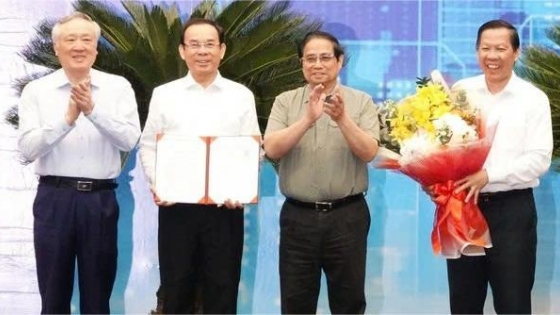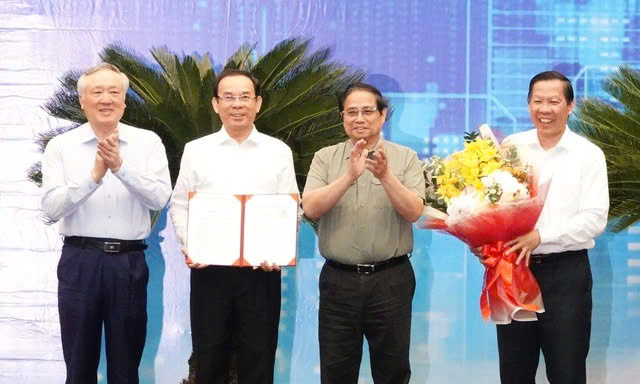Infra
HCMC prioritizes infrastructure, innovation hubs, data centers under new master plan

By
Minh Hue
Sun, January 5, 2025 | 8:00 am GMT+7
Ho Chi Minh City seeks to mobilize over VND4.4 trillion ($173 million) between 2026 and 2030 to implement key infrastructure projects such as ring roads, expressways, bridges, and seaports according to its newly approved master plan, said the city mayor.
Chairman of the Ho Chi Minh City People’s Committee Phan Van Mai speaks at the ceremony. Photo courtesy of Tuoi tre (Youth) newspaper.
At a conference to announce the city’s master plan for the 2021-2030 period, with a vision towards 2050, HCMC Chairman Phan Van Mai said the city will build Ho Chi Minh City-Moc Bai Expressway, Ring Road 2, Ring Road 3, Ring Road 4, and four major bridges Can Gio, Thu Thiem 4, Dong Nai 2 and Phu My 2.
It will also invest in Thu Thiem-Long Thanh and HCMC-Can Tho railways, seven urban rail lines, Can Gio international transshipment port and Nha Rong-Khanh Hoi international passenger port.
He noted that HCMC is prioritizing the development of science and technology with projects like startup and innovation hubs, data centers, and the Thu Duc Science and Technology Park.
It will also continue investing in large industrial zones such as Pham Van Hai I, Pham Van Hai II and An Phu; industrial clusters; as well as energy infrastructure and biotechnology facilities like the Hiep Phuoc LNG power plant and the National Biotechnology Center.
Sharing the major goals of the master plan, Mai said HCMC aims to become a global city with a high-quality workforce and modern services and industries by 2030, leading in green economy, digital economy and digital society.
It seeks to become a sustainable and attractive global city and a leading economic, financial, and service center in Asia by 2050.
The city’s gross regional domestic product (GRDP) per capita is projected to reach VND385-405 million ($14,800-15,400) by 2030. Its population is estimated at around 11 million by 2030 and approximately 14.5 million by 2050.

Prime Minister Pham Minh Chinh hands over a decision approving Ho Chi Minh City’s master plan for the 2021-2030 period, with a vision towards 2050. Photo couresy of Tuoi Tre (Youth) newspaper.
At the event, Prime Minister Pham Minh Chinh suggested that HCMC pilot new mechanisms and policies, especially for dynamic projects such as the international financial center, Can Gio port, roads linking Tan Son Nhat International Airport with Long Thanh International Airport in neighboring Dong Nai province, and urban rail lines.
HCMC should quickly establish an area displaying its development plans and key projects calling for private investment to ensure transparency. This is a practice adopted by cities around the world, helping investors quickly understand local development plans without meeting its leaders, he added.
At the conference, PM Pham Minh Chinh revealed that he had suggested billionaire Pham Nhat Vuong, chairman of Vingroup, build a subway from downtown HCMC to the outlying district of Can Gio, and Vuong agreed with pleasure.
In July 2024, the Department of Transport and the Department of Planning and Architecture of HCMC reached an agreement to propose including an urban railway line from the city center to Can Gio in the adjusted HCMC plan until 2040, with a vision toward 2060. This rail line proposal came after the Prime Minister paid a field trip to Can Gio district on July 18, 2023.
In 2023, the units studying the adjustment of HCMC’s urban railway system also proposed the city consider adding three new metro lines, including one crossing the Soai Rap River to Can Gio, connecting to the 2,870-hectare coastal tourist urban area in Can Gio.









